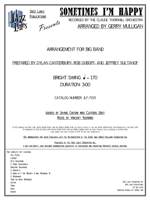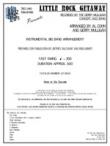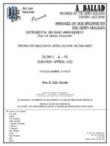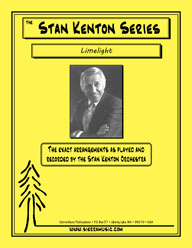SOMETIMES I'M HAPPY [DOWNLOAD]
Recorded by The Claude Thornhill Orchestra
Arranged by Gerry Mulligan, Prepared by Dylan Canterbury, Rob DuBoff, and Jeffrey Sultanof

Cat #: JLP-7193-DL
$75.00This product is available for immediate download after purchase.
Questions?
Please call +1-518-587-1102 or email us.
Edition: Jazz Big Band Arrangement
Description: Swing - Difficult
Publisher: Jazz Lines Publications
This arrangement of Sometimes I'm Happy comes from a fairly early period in Gerry Mulligan's career - he wrote it in 1947 for the Claude Thornhill Orchestra. Nevertheless, several of the trademarks of Mulligan's arranging style (warm ensemble voicings, clever rhythmic ideas and brilliant shout choruses) are already clearly in place. Keep in mind that although the volume level and brass ranges are moderate at best, there is an unquestionably hard-swinging nature to the arrangement that should be milked for all it's worth.
The original introduction for the arrangement, which was discarded, starts out with some punctuated brass hits over lower register held tones in the low brass and winds, culminating in a brief ascending figure before the melody's entrance at measure 11. Said melody is handled by Thornhill on piano in a block chord style that seems to be hinting at the approach George Shearing would soon become famous for. The full band enters for a key change (from C major to F major) at measure 31. Mulligan does an extremely clever job of playing around with the melody during this section, almost as if he took one of his own performances of the tune and orchestrated it. The band never gets around to stating the second half of the melody, as an alto sax solo takes the spotlight at measure 45. The backgrounds underneath alternate from being gently supportive to borderline contrapuntal.
Another key change (to Bb major) occurs for the next chorus of the form at measure 63. This chorus is split between a trumpet solo (from measure 63 to 78) and a tenor sax solo (from measure 79 to 92). Each of these solos are introduced by a tricky unison ensemble line that is clearly influenced by the at-the-time burgeoning bebop movement. Despite requiring some dexterous fingers, these passages should all sound as relaxed and effortless as possible. The ensemble gets to flex its muscles in a brief but highly engaging shout chorus after yet another key change (to G major) at measure 95. Pay attention to the articulation markings during this section, as they create a sense of implied syncopation that serves as a wonderfully creative way of setting up rhythmic tension. A quick guitar solo at measure 103 sets up one final key change, this time a return to F major, where the ensemble initially entered. The melody is largely copied from its first appearance toward the beginning of the arrangement, with the exception of the ending. Said ending figure is quite simple, but does a lovely job of bringing things to a warm and mellow conclusion.
This arrangement is for jazz big band with two horns in F and tuba. It is not a transcription - it has been prepared from Gerry Mulligan's original score. Woodwind 1 is on clarinet throughout. If you do not have access to French horn players, alternate parts for trumpet and trombone have been included. The tuba part can be performed on bass trombone. The arrangement's introduction was cut for the original recording, which begins at measure 9. We have included the introduction if you wish to perform the chart as originally written. If you choose to start at 9, all parts marked "optional" should not be played. In addition, the original recording skips the first ending at measure 19.
Clarinet
Alto Saxophone
2 Tenor Saxophones
Baritone Saxophone
3 Trumpets
2 Horns in F (Or Trumpet 3 and Trombone 3)
2 Trombones
Tuba (or Bass Trombone)
Guitar
Piano
Bass
Drums
Trombone 1: Bb4









